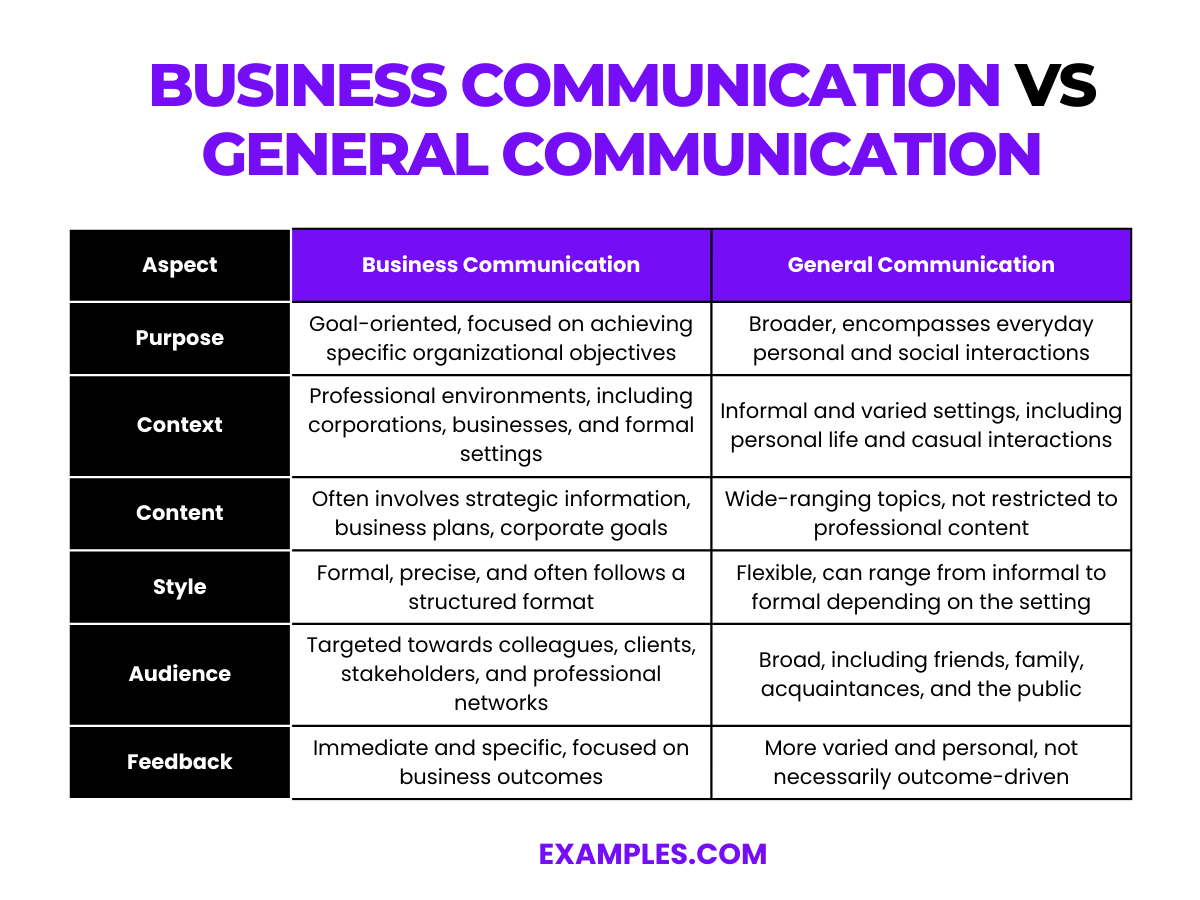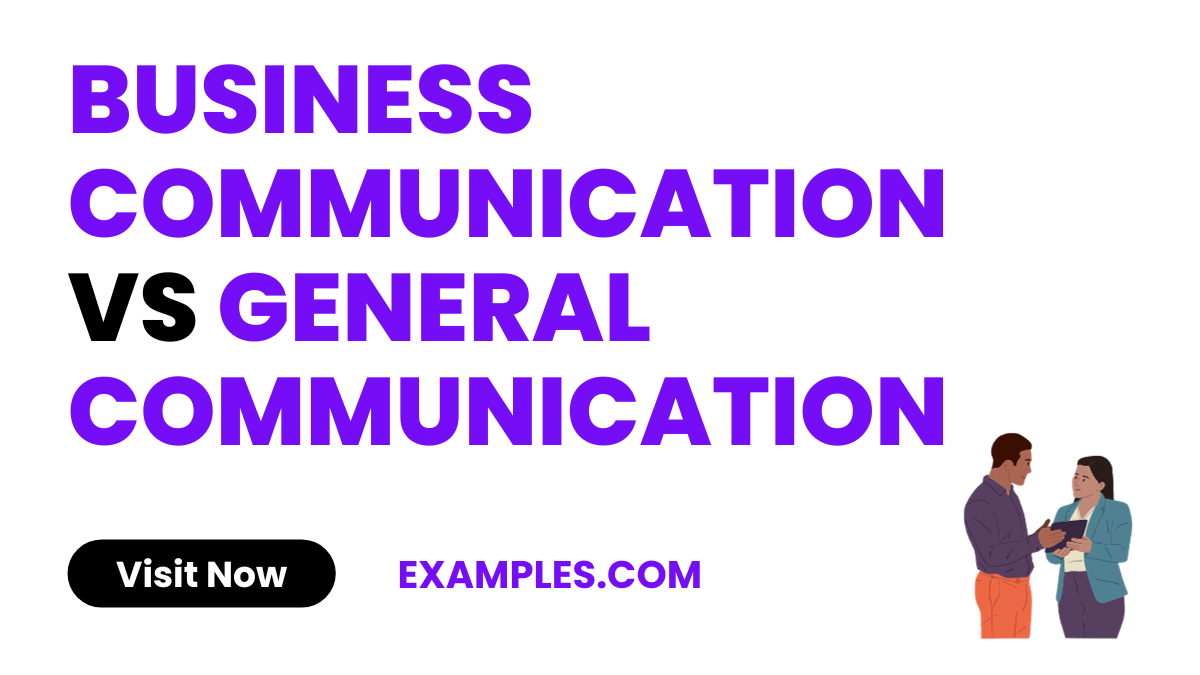Business Communication vs General Communication: Difference Between, Examples, PDF
Dive into the essential world of communication with our complete guide contrasting Business Communication and General Communication. This resource, rich in communication examples, details how structured, goal-driven Business Communication varies from the more varied and informal nature of General Communication. Packed with real-world scenarios, this guide illuminates the unique dynamics, techniques, and impacts of each communication style. It’s an invaluable tool for anyone looking to understand and apply these two pivotal forms of communication in their professional and personal lives.
Download Business Communication in PDF
Download General Communication PDF
Difference Between Business Communication vs General Communication
 The distinction between Business Communication and General Communication is an important aspect to understand in both professional and personal contexts. Business Communication is tailored specifically for professional settings, with a focus on clear, goal-oriented, and formal interactions. It revolves around conveying information effectively within a business environment. In contrast, General Communication covers a broader spectrum, encompassing casual, everyday interactions that are not limited to professional content or environments. This guide aims to clarify these differences, helping readers navigate and apply the appropriate communication style in various situations.
The distinction between Business Communication and General Communication is an important aspect to understand in both professional and personal contexts. Business Communication is tailored specifically for professional settings, with a focus on clear, goal-oriented, and formal interactions. It revolves around conveying information effectively within a business environment. In contrast, General Communication covers a broader spectrum, encompassing casual, everyday interactions that are not limited to professional content or environments. This guide aims to clarify these differences, helping readers navigate and apply the appropriate communication style in various situations.
| Aspect | Business Communication | General Communication |
|---|---|---|
| Purpose | Goal-oriented, focused on achieving specific organizational objectives | Broader, encompasses everyday personal and social interactions |
| Context | Professional environments, including corporations, businesses, and formal settings | Informal and varied settings, including personal life and casual interactions |
| Content | Often involves strategic information, business plans, corporate goals | Wide-ranging topics, not restricted to professional content |
| Style | Formal, precise, and often follows a structured format | Flexible, can range from informal to formal depending on the setting |
| Audience | Targeted towards colleagues, clients, stakeholders, and professional networks | Broad, including friends, family, acquaintances, and the public |
| Feedback | Immediate and specific, focused on business outcomes | More varied and personal, not necessarily outcome-driven |
| Tools | Professional channels like business emails, reports, presentations | Diverse, including social media, casual conversations, personal letters |
This table highlights the key differences between Business Communication and General Communication, illustrating how each is tailored to its specific context and audience, with distinct purposes and styles. Understanding these differences is essential for effective communication in both professional and personal realms.
10 Business Communication Examples
Business Communication is a vital aspect of professional life, encompassing various forms and methods used to convey information and ideas within a business context. It plays a critical role in ensuring smooth and effective operations, fostering professional relationships, and achieving organizational goals. Here are unique and distinct examples of Business Communication:
- Emails: A primary mode of written communication in business, used for quick, formal exchanges.
- Meetings: Regularly held to discuss and strategize on business matters.
- Reports: Detailed documents presenting data and analysis for decision-making.
- Presentations: Used to share and explain complex information in an understandable way.
- Business Letters: Formal letters for external communication.
- Memos: Short messages to inform or instruct employees internally.
- Newsletters: Regular updates about company news and events.
- Press Releases: Official statements for public media.
- Corporate Websites: Online representation of a company’s brand and information.
- Social Media: Platforms used for branding, marketing, and customer engagement.
10 General Communication Examples
General Communication encompasses the wide array of interactions we engage in daily, beyond the confines of a professional setting. It includes casual conversations, social media interactions, and personal correspondence, reflecting the natural, diverse ways we communicate in our everyday lives. These forms of communication are often informal, spontaneous, and can vary greatly in content and style, depending on the context and relationship between the communicators.
- Casual Conversations: Informal talks with friends or family about various topics.
- Text Messaging: Quick, informal exchanges, often using slang or emojis.
- Social Media Posts: Sharing personal experiences or opinions online.
- Personal Emails: Non-professional email communication with friends or relatives.
- Phone Calls: Voice conversations for social or personal reasons.
- Video Chats: Face-to-face conversations over digital platforms for personal interaction.
- Letters/Postcards: Traditional forms of personal correspondence.
- Public Speaking: Speaking at non-professional events like weddings or clubs.
- Community Meetings: Local gatherings to discuss neighborhood issues.
- Blogs/Vlogs: Personal online content sharing thoughts, experiences, or hobbies.
Comparison Between Business Communication and General Communication
Business Communication and General Communication are two distinct but equally important realms within the communication spectrum. This guide aims to delineate the key differences between them, aiding professionals and individuals in understanding and applying these forms effectively in their respective domains.
- Purpose: Business Communication is focused on achieving organizational objectives, while General Communication encompasses a broader range of personal and social goals.
- Context: Business Communication often takes place in professional settings, whereas General Communication is prevalent in a variety of environments.
- Content: The content of Business Communication is typically centered around business-related topics, while General Communication can cover any subject.
- Style and Tone: Business Communication is generally more formal and structured; General Communication offers flexibility, ranging from informal to formal.
- Audience: The audience for Business Communication includes colleagues, clients, and stakeholders, whereas General Communication addresses a wider, more diverse audience.
- Channel of Communication: Business Communication often utilizes professional channels like emails, reports, and meetings, while General Communication uses more varied channels, including personal conversations and social media.
- Feedback: In Business Communication, feedback is usually prompt and directly related to business tasks. In contrast, feedback in General Communication can be more diverse and personal.
- Goals: The primary goal of Business Communication is to inform, persuade, or collaborate in a business context, while General Communication aims to connect, share, or express on a personal level.
- Language Use: Business Communication often employs industry-specific jargon, while General Communication uses language that is more universally accessible.
- Efficiency and Clarity: Business Communication stresses efficiency and clarity due to its goal-oriented nature. General Communication may allow for more expressive and elaborate language.
- Cultural Sensitivity: Both forms require cultural sensitivity, but Business Communication demands a higher level of professional etiquette and awareness of business norms.
- Legal and Ethical Considerations: Business Communication is often bound by legal and ethical considerations, especially in formal documents and contracts, unlike General Communication.
Relationship Between Business Communication and General Communication
Understanding the relationship between Business Communication and General Communication is crucial as they often intersect in professional environments.
- Foundation: General Communication skills form the basis for effective Business Communication.
- Skill Transferability: Skills learned in General Communication can enhance Business Communication effectiveness.
- Audience Understanding: Knowing how to communicate generally helps in tailoring business messages for diverse audiences.
- Feedback Integration: Feedback principles in General Communication apply to Business Communication for improvement.
- Adaptability: Adaptation skills from General Communication are vital in diverse business contexts.
- Conflict Resolution: Techniques from General Communication aid in resolving business conflicts.
- Cultural Sensitivity: Understanding from General Communication helps navigate cultural nuances in business.
- Non-Verbal Cues: General Communication emphasizes the importance of non-verbal signals, crucial in business settings.
- Technology Utilization: The use of technology in General Communication overlaps with digital platforms in Business Communication.
- Networking: General Communication skills are essential for effective business networking.
- Persuasion Techniques: Persuasive skills from General Communication are often employed in business scenarios.
- Continuous Learning: Principles of learning and adapting in General Communication are integral to evolving Business Communication strategies.
In Conclusion, the article “Business Communication vs General Communication” on Examples.com provides a comprehensive analysis of the differences between these two types of communication. It covers various aspects such as purpose, context, audience, and style, highlighting the more structured, goal-oriented nature of business communication compared to the broader scope of general communication.
For those seeking further exploration into this topic, additional insights can be found at FindMotivation and Central Michigan University, which offer valuable resources and perspectives on business and general communication practices.


